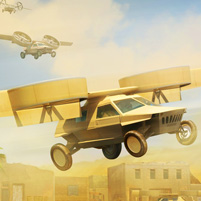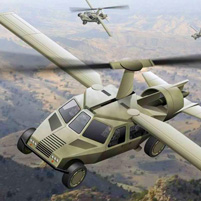Flying Cars


A car that can fly itself would be a valuable resource for the U.S. military — especially rescue workers needing to provide quick evacuations in various terrains.
The Defense Advanced Research Projects Agency (DARPA) has awarded a 17-month, $988,000 contract to Carnegie Mellon's Robotics Institute to develop such a vehicle.
The RI will develop an autonomous flight system for the Transformer (TX) Program, which is exploring the feasibility of a military ground vehicle that could transform into a vertical-take-off-and-landing (VTOL) air vehicle.
The TX vehicle envisioned by DARPA would be capable of transporting four people and 1,000 pounds of payload up to 250 nautical miles, either by land or by air.
Its enhanced mobility would increase survivability by making movements less predictable and would make the vehicle suitable for a wide variety of missions.
"The TX is all about flexibility of movement and key to that concept is the idea that the vehicle could be operated by a soldier without pilot training," said Sanjiv Singh, CMU research professor of robotics.
"In practical terms, that means the vehicle will need to be able to fly itself, or to fly with only minimal input from the operator. And this means that the vehicle has to be continuously aware of its environment and be able to automatically react in response to what it perceives."
Carnegie Mellon has a long history of leadership in autonomous navigation — including the self-driving SUV called Boss, the winning entry in DARPA's Urban Challenge robot road race in 2007 and DepthX, an autonomous NASA submarine that explored the world's deepest sinkhole.
Singh applied expertise in robotic perception and planning to demonstrate a fully autonomous helicopter flying in between wires, trees and buildings in DARPA's Organic Air Vehicle II (OAV2) Program. And, working with Piasecki Aircraft earlier this year, he demonstrated an unprecedented feat: that a full-size helicopter could avoid low altitude obstacles, select a landing site and land without human input.
Carnegie Mellon is one of six contractors DARPA has chosen for the TX program. The focus of CMU's program will be on situational awareness, collision avoidance and intuitive control.
Honeywell Laboratories, which worked with Carnegie Mellon in the OAV2 program, is a subcontractor to Carnegie Mellon and will work on the human factors issues associated with the program.
AAI Corp. and Lockheed Martin Co. were selected by DARPA as prime system integrators for the first phase of the TX program, developing overall design concepts for the transforming vehicle.
Pratt & Whitney Rocketdyne, which is developing engine technology, and Carnegie Mellon were selected as "critical enabling technology" vendors.
Related Links: Robotics Institute | Unprecedented Feat | School of Computer Science
